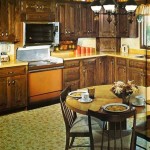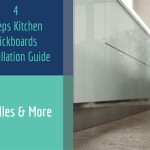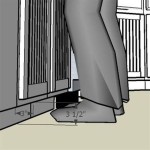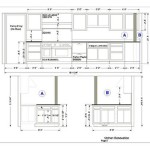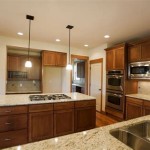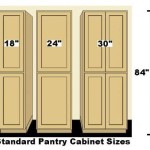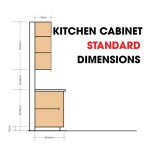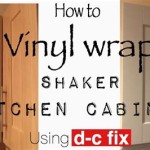How To Repair a Kitchen Cabinet Pulling Away From the Wall
A kitchen cabinet pulling away from the wall is a common household problem. This issue can be caused by several factors, including weakened screws, excessive weight inside the cabinet, water damage, or simply the natural settling of the house. Addressing this promptly is important, as ignoring the problem can lead to further damage, such as the cabinet completely detaching from the wall, damaging the wall itself, or even causing injury.
Before attempting to repair a cabinet pulling away from the wall, it is crucial to understand the underlying cause. This will help determine the appropriate repair method and prevent the issue from recurring. For instance, if water damage is the culprit, simply tightening the screws will be a temporary fix. The water leak must be addressed first. Similarly, overloading the cabinet with heavy items will constantly strain the fasteners, regardless of how sturdy they initially seem.
Safety is paramount when undertaking any home repair project. Before starting, ensure the work area is well-lit and clear of obstacles. Wear safety glasses to protect the eyes from debris. If power tools are used, familiarize yourself with their operation and safety guidelines. Finally, if the cabinet is particularly large or heavy, enlist the help of another person to prevent injury during the repair process.
Diagnosing the Problem
The first step in repairing a cabinet pulling away from the wall is to accurately diagnose the cause. A thorough inspection of the cabinet, the wall around it, and the surrounding area is essential. This diagnosis will guide the repair process and ensure a lasting solution.
Begin by examining the screws that secure the cabinet to the wall. Are they loose, stripped, or broken? If the screws are simply loose, tightening them may be sufficient. However, if they are stripped or broken, they will need to be replaced. The type of screw used is also important; often, builders-grade screws are not long enough or strong enough for the application. Consider replacing them with longer, more robust screws designed for cabinet installation.
Next, inspect the wall itself. Look for signs of damage, such as cracks, holes, or crumbling drywall. If the drywall is damaged, the screws will likely not hold properly. In this case, the drywall will need to be repaired or reinforced before the cabinet can be securely reattached. Moisture staining, discoloration, or a musty odor are all strong indicators of water damage. Identify the source of the leak and repair it before proceeding with any other repairs.
Assess the weight distribution inside the cabinet. Overloading a cabinet, especially with heavy items like dishes or canned goods, can put excessive strain on the mounting hardware and cause it to pull away from the wall. Redistribute the weight by moving some of the heavier items to other cabinets or storage areas. Consider installing additional shelving or supports inside the cabinet to better distribute the load.
Check the level of the cabinet. If the cabinet is not level, it will put uneven stress on the mounting points, which can also cause it to pull away from the wall. Use a level to check both the top and the bottom of the cabinet. If the cabinet is not level, shims can be used to adjust its position. These shims should be placed behind the cabinet, near the mounting points, to provide support and ensure a level surface.
Repairing Loose Screws and Stripped Holes
If the primary issue is loose or stripped screws, various methods can be employed to restore a secure connection between the cabinet and the wall. The selection of the method depends on the severity of the problem and the condition of the surrounding drywall.
For screws that are simply loose, tightening them might be a temporary solution. However, to ensure a more permanent fix, consider using slightly longer screws of the same diameter. This will allow the screws to bite into fresh wood and provide a more secure hold. Before tightening, apply a small amount of wood glue to the screw threads. This will help to bind the screw to the wood and prevent it from loosening again.
Stripped screw holes in drywall present a more challenging problem. One common solution involves using drywall anchors. These anchors are inserted into the stripped hole and provide a secure anchor point for the screw. Various types of drywall anchors are available, including plastic anchors, metal anchors, and self-drilling anchors. Choose an anchor that is appropriate for the weight of the cabinet and the thickness of the drywall. Follow the manufacturer's instructions for installing the anchor. Once the anchor is in place, the screw can be inserted, providing a much stronger hold than it would have in the stripped hole.
Another option for repairing stripped screw holes is to use wood filler or dowels. If the hole is not too large, wood filler can be used to fill the hole. Allow the wood filler to dry completely according to the manufacturer's instructions. Once the filler is dry, drill a pilot hole and then re-install the screw. For larger holes, a dowel can be used. Choose a dowel that is slightly larger than the diameter of the hole. Apply wood glue to the dowel and insert it into the hole. Allow the glue to dry completely. Once the glue is dry, use a saw or chisel to trim the dowel flush with the wall. Drill a pilot hole and then re-install the screw.
When dealing with particularly large or damaged holes, consider using a backing board. Cut a piece of wood that is slightly larger than the hole. Apply construction adhesive to the back of the backing board and position it behind the drywall, covering the hole. Secure the backing board to the surrounding studs using screws. Once the adhesive is dry, patch the hole with drywall compound. Sand the patch smooth and then paint to match the surrounding wall.
Reinforcing the Cabinet Mounting
In many cases, simply repairing the screw holes is not enough to prevent the problem from recurring. Reinforcing the cabinet mounting is often necessary to provide additional support and ensure that the cabinet remains securely attached to the wall. Several methods can be used to reinforce the cabinet mounting, depending on the specific situation.
The most basic method involves adding additional screws to the cabinet mounting. Identify the studs in the wall behind the cabinet. Use a stud finder to locate the studs accurately. Drive longer, heavier-duty screws through the cabinet and into the studs. This will provide a much stronger connection than relying solely on screws anchored in drywall. Ensure that the screws are long enough to penetrate at least 1 inch into the stud.
Another effective method is to install metal L-brackets. These brackets are attached to the inside of the cabinet and then screwed into the wall studs. The L-brackets provide a strong and rigid connection between the cabinet and the wall. Choose brackets that are made of heavy-gauge steel and that are appropriately sized for the weight of the cabinet. Position the brackets strategically to provide maximum support. Typically, brackets are placed near the top and bottom of the cabinet, as well as near any areas that are particularly stressed.
For cabinets that are particularly heavy or that are prone to shifting, consider installing a French cleat. A French cleat is a two-part mounting system that consists of a beveled strip of wood that is attached to the wall and a corresponding beveled strip that is attached to the back of the cabinet. The two strips interlock, providing a strong and secure connection. French cleats are particularly useful for mounting heavy cabinets because they distribute the weight evenly across the wall. They also allow for easy removal and re-installation of the cabinet, if necessary.
If the cabinet is pulling away from the wall due to sagging or uneven flooring, shimming the cabinet is essential. Use shims to level the cabinet and provide support where needed. Place the shims between the bottom of the cabinet and the floor, or behind the cabinet where it meets the wall. Ensure that the shims are securely in place and that they do not interfere with the operation of the cabinet doors or drawers. Use a level to ensure that the cabinet is perfectly level before tightening any screws or fasteners.
Finally, consider the weight distribution within the cabinet. Avoid overloading the cabinet with heavy items. Redistribute the weight by moving some of the heavier items to other cabinets or storage areas. Consider installing additional shelving or supports inside the cabinet to better distribute the load. Proper weight distribution will help to prevent the cabinet from pulling away from the wall in the future.
By carefully diagnosing the problem, repairing any damaged screw holes, and reinforcing the cabinet mounting, the kitchen cabinet can be securely reattached to the wall, ensuring its stability and longevity.

Cabinets Pulling Away From Wall Doityourself Com Community Forums

Cabinets Pulling Away From Wall

Cabinet Bowing Out At Top On One End Hometalk

Cabinet Side Separating How To Fix Doityourself Com Community Forums

How To Repair A Kitchen Cabinet That Is Pushing Out On The Side Hometalk

Baseboards Pulling Away From Wall

Cabinet Side Separating How To Fix Doityourself Com Community Forums

Cabinets Pulling Away From Wall Doityourself Com Community Forums

How To Fix Sagging Cabinets Quickly And Easily Kitchen Infinity

Granite Countertop Separating From Wall

